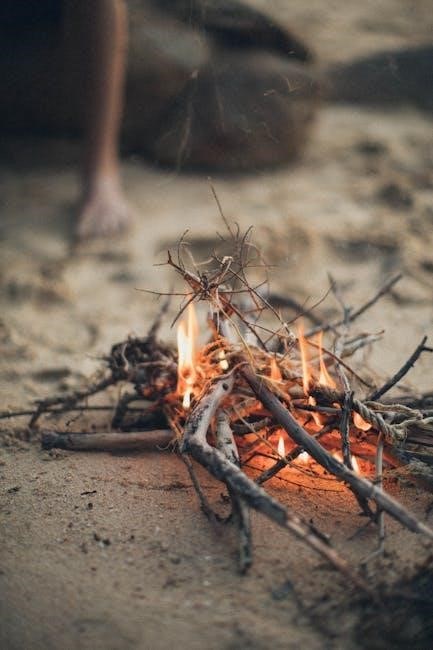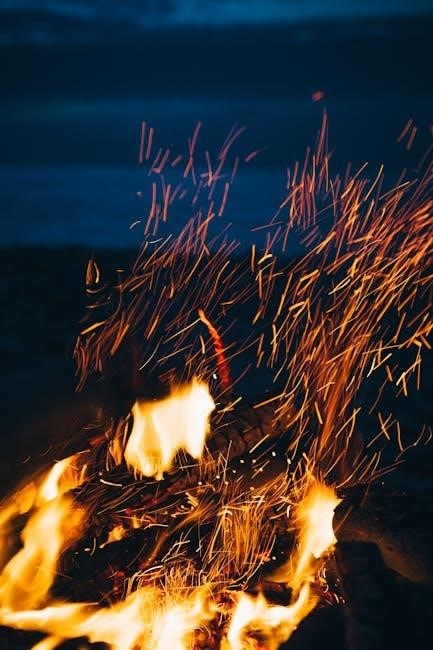wilderness long-term survival guide
Summary
Master wilderness survival skills! Learn how to find food, build shelter, and navigate for long-term survival in the wild. Expert tips and strategies inside.

Wilderness long-term survival requires a mix of practical skills and mental resilience. This guide covers shelter building, water purification, fire starting, food procurement, navigation, and signaling for help effectively.
1.1 Key Principles of Thriving in the Wild
Thriving in the wild begins with a positive mental attitude and preparation. Understanding the environment and leveraging natural resources is crucial for long-term survival. Key principles include adapting to nature, conserving energy, and maintaining sustainability. A well-prepared mindset allows individuals to stay calm and make rational decisions under stress. Knowledge of essential skills, such as knot-tying, water purification, and shelter construction, forms the foundation of wilderness survival. Additionally, sustainable practices like foraging and hunting ensure a steady food supply without depleting resources. By mastering these principles, individuals can transform a survival situation into an opportunity to thrive in harmony with nature.
Essential Survival Skills
Mastering water purification, shelter building, fire starting, food procurement, navigation, and signaling is vital for wilderness survival. These skills ensure sustainability and safety in the wild.
2.1 Water Purification Methods

Water purification is critical for wilderness survival. Boiling is the most reliable method, killing bacteria, viruses, and parasites. Sand filtration systems can remove particulates, while solar disinfection (SODIS) uses UV light to sanitize water. Chemical treatments like chlorine or iodine are effective but require careful dosing. Always store purified water in clean containers to prevent re-contamination. Avoid sources near agricultural runoff or animal habitats to reduce risk of pollution. Proper hydration is essential, so mastering these techniques ensures safe drinking water, crucial for long-term survival in the wild.
2.2 Shelter Building Techniques
Building an effective shelter is vital for protection from harsh weather and wildlife. Start by identifying sturdy branches or trees to serve as the frame. A lean-to shelter can be constructed using a ridgepole supported by two upright posts and covered with leaves, grasses, or pine needles. Ensure the structure is angled to allow water runoff. Consider natural formations like rock overhangs or fallen trees as pre-made shelters. Digging a snow trench or creating a quinzhee shelter is ideal in snowy conditions. Always prioritize a dry, elevated location near resources like water and firewood. A well-built shelter not only provides physical protection but also boosts morale, essential for long-term survival.
2.3 Fire Starting Strategies
Starting a fire is a cornerstone of wilderness survival, providing warmth, light, and a way to cook food. Use a flint and steel or ferro rod to create sparks, directing them onto a tinder bundle of dry leaves, grass, or bark. The bow drill method is another reliable technique, using friction to generate heat. Once a spark ignites the tinder, gently blow to expand the flame. Maintain the fire by gradually adding larger logs. Keep it contained with rocks to prevent spreading. A fire not only signals for help but also boosts morale and aids in food preparation. Always prioritize fire safety to avoid accidents and respect the environment.
Food Procurement and Preparation
Procuring and preparing food in the wild involves effective hunting, gathering, and cooking techniques to ensure meals are nutritious and safe for consumption during survival situations.
3.1 Foraging for Wild Edibles
Foraging for wild edibles is a crucial survival skill, providing sustainable food sources in the wilderness. It requires knowledge of edible plants, their seasons, and habitats. Always prioritize safety by correctly identifying plants to avoid poisoning. Universal edibility tests can help verify safety. Tools like knives or baskets are essential for harvesting. Focus on abundant species to ensure sustainability. Learn to recognize plants like berries, nuts, greens, and roots. Practice ethical foraging to preserve ecosystems. Seasonal awareness is key, as availability varies. Combine foraged foods with hunted or trapped resources for a balanced diet. This skill not only sustains life but also fosters a deeper connection with nature.
3.2 Hunting and Trapping Techniques
Hunting and trapping are essential skills for long-term wilderness survival, ensuring a reliable protein source. Start with simple traps like snare traps or pitfall traps, using materials like cordage, sticks, and rocks. Understand animal behavior to set traps effectively, targeting common prey such as rabbits, squirrels, or birds. Hunting requires precision and patience; use weapons like bows, spears, or slingshots for efficiency. Always aim for clean kills to minimize suffering and preserve meat. Learn proper skinning and cleaning techniques to prepare game for consumption. Preserve meat through smoking, drying, or caching to sustain yourself over time. Ethical hunting and trapping practices are crucial to maintain ecological balance and ensure long-term food security in the wild.

Navigation and Orientation
Navigation and orientation are critical for wilderness survival. Use natural landmarks like rivers, mountains, and valleys to guide yourself. Learn celestial navigation using the sun and stars to determine direction. Creating a mental map of your surroundings helps track your position and movement. Pay attention to vegetation patterns and animal trails, as they often indicate water sources or paths. Stay observant and methodical to avoid disorientation and ensure safe traversal of the wild terrain.
4.1 Using Natural Landmarks
Using natural landmarks is a fundamental navigation technique in wilderness survival. Rivers, mountains, and valleys can serve as guides to maintain direction. Animal trails often lead to water sources or natural pathways, while vegetation patterns may indicate soil quality or moisture. Pay attention to the position of the sun and stars, as they provide reliable directional cues. In forests, moss growth on tree trunks can indicate north, though this varies by region. By observing these natural features, you can create a mental map of your surroundings. Staying attuned to your environment and using landmarks effectively ensures better navigation and reduces the risk of disorientation in the wild.
4.2 Creating a Mental Map
Creating a mental map is crucial for effective navigation in the wilderness. Start by observing prominent natural features such as rivers, ridges, and valleys. Note the direction of the sun, moon, and stars to establish a sense of orientation. As you move, mentally mark landmarks like unusual trees or rock formations to track your path. Update your mental map regularly to reflect new discoveries, ensuring accuracy. This skill helps reduce disorientation and aids in retracing your steps or finding your way back to camp. Over time, practice improves your ability to visualize terrain, making navigation more intuitive and reliable in unfamiliar territories.

Signaling for Help
Signaling for help is vital for rescue in the wilderness. Use smoke during the day and fires at night to attract attention. Reflective objects like mirrors or metal can signal planes or distant observers. Ensure your signals are visible from multiple angles and follow international distress patterns like SOS. Visibility is key, so choose open areas for signal fires or create large, noticeable marks on the ground. Consistent signaling increases the likelihood of being spotted by rescue teams or passing aircraft. Stay patient and persistent, as help may take time to arrive.
5;1 Using Smoke Signals

Smoke signals are a proven method for signaling help in the wilderness; Create smoke during daylight hours to maximize visibility. Use dry wood for thick smoke and green leaves or wet wood for lighter, more visible plumes. Build a fire on a hilltop or open area to ensure visibility from all directions. Create three short bursts of smoke, as this is an internationally recognized distress signal. Maintain consistent smoke output to attract attention from rescue teams or passing aircraft. Use reflective materials like mirrors or shiny objects to enhance visibility. Ensure your fire is safe and controlled to avoid unintended wildfires. Smoke signals are most effective in clear weather conditions when visibility is high. Stay patient and persistent, as rescue teams may take time to locate you.
5.2 Building Signal Fires
Building signal fires is a critical survival technique to alert rescuers. Choose a visible location, such as a hilltop or clearing, to maximize visibility. Use dry, flammable materials like branches and leaves to create a fire that produces thick smoke during the day. At night, a bright, consistent flame is more noticeable. Arrange fires in a triangle formation to signal distress universally. Keep the fires small to avoid unintended wildfires but large enough to be seen from a distance. Ensure the fire is tended to maintain its size and intensity, especially at night when visibility is lower. Signal fires are most effective when paired with other signaling methods like smoke during daylight hours. Always prioritize fire safety to prevent accidental spread while signaling for help.